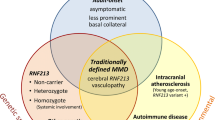Abstract
Background
Moya moya type vasculopathy (MMV) is a rare disorder in which there is narrowing of bilateral intracranial carotid arteries (Scott and Smith in New Engl J Med 360(12):1226–1237, 2009). MECP2 duplication syndrome (MDS) is a rare genetic disorder that is caused by genetic duplications on Xq28 chromosome (Expanding the clinical picture of the MECP2 duplication syndrome. (Lim et al. in Clin Genet 91(4):557–563, 2017). Both disorders are rare and have not been described together in association.
Case Presentation
Interestingly, we present a child with both MDS and MMV. Upon genetic testing, there was found to be a large, de novo duplication sequence in the patient’s genome. Possible correlation between our patient’s extensive genetic mutation and MMV has been evaluated.
Conclusion
Our literature search disclosed no other known patients with both MDS and MMV. Patients with MDS should be monitored carefully for signs or symptoms of vasculopathy.
Similar content being viewed by others
References
Scott, Smith ER (2009) Moyamoya disease and moyamoya syndrome. New Engl J Med 360(12):1226–1237. https://doi.org/10.1056/NEJMra0804622
Lim Downs J, Wong K, Ellaway C, Leonard H (2017) Expanding the clinical picture of the MECP2 duplication syndrome. Clin Genet 91(4):557–563. https://doi.org/10.1111/cge.12814
Ta D et al (2022) A brief history of MECP2 duplication syndrome: 20-years of clinical understanding - Orphanet Journal of Rare Diseases. BioMed Central. https://doi.org/10.1186/s13023-022-02278-w
Ramocki MB (2010) The MECP2 duplication syndrome. Wiley Online Library. https://doi-org.proxy.libraries.rutgers.edu/10.1002/ajmg.a.33184
Starke RM et al (2012) Moyamoya disorder in the United States. Neurosurgery 71(1):93–99. https://doi.org/10.1227/neu.0b013e318253ab8e
Van Esch H (2012) MECP2 duplication syndrome. Molecular Syndromology, S. Karger AG, 2012. https://www.ncbi.nlm.nih.gov/pmc/articles/PMC3366699/
Peters SU et al (2015) Diurnal salivary cortisol and regression status in MECP2 duplication syndrome. J Child Neurol. https://doi-org.proxy.libraries.rutgers.edu/10.1177/0883073815585577
Tarasów Kułakowska A, Lukasiewicz A, Kapica-Topczewska K, Korneluk-Sadzyńska A, Brzozowska J, Drozdowski W (2011) Moyamoya disease: diagnostic imaging. Pol J Radiol 76(1):73–79
Gupta A, Tyagi A, Romo M, Amoroso KC, Sonia F (2020) Moyamoya disease: a review of current literature. Cureus 12(8):e10141. https://doi.org/10.7759/cureus.10141
Shoukat S, Itrat A, Taqui AM et al (2009) Moyamoya disease: a clinical spectrum, literature review and case series from a tertiary care hospital in Pakistan. BMC Neurol 9:15. https://doi.org/10.1186/1471-2377-9-15
Berry JA, Cortez V, Toor H, Saini H, Siddiqi J (2020) Moyamoya: an update and review. Cureus 12(10):e10994. https://doi.org/10.7759/cureus.10994
Peters Kundishora ST, Pinard A, Duran D, Panchagnula S, Barak T, Miyagishima DF, Dong W, Smith H, Ocken J, Dunbar A, Nelson-Williams C, Haider S, Walker RL, Li B, Zhao H, Thumkeo D, Marlier A, Duy PQ, Kahle KT (2021) DIAPH1 variants in non–East Asian patients with sporadic moyamoya disease. JAMA Neurol 78(8):993–1003. https://doi.org/10.1001/jamaneurol.2021.1681
Chibli R, Omor Y, Sebbouba NS, Hassani MRE, Jiddane M, Fikri M (2017) Moya moya disease: a rare cause of ischemic stroke in children: about a case. Pan Afr Med J 28:192–192. https://doi.org/10.11604/pamj.2017.28.192.8740
Mertens R, Graupera M, Gerhardt H, Bersano A, Tournier-Lasserve E, Mensah MA, Mundlos S, Vajkoczy P (2022) The genetic basis of moyamoya disease. Transl Stroke Res 13(1):25–45. https://doi.org/10.1007/s12975-021-00940-2
Guey S, Tournier-Lasserve E, Hervé D, Kossorotoff M (2015) Moyamoya disease and syndromes: from genetics to clinical management. Appl Clin Genet 8:49–68. https://doi.org/10.2147/TACG.S42772
Author information
Authors and Affiliations
Contributions
G.H., C.M., J.K., D.M., wrote the main manuscript text. J.R. prepared the imaging and titling for images. D.A. conducted genomic testing and dictated genetic report. G.H. and J.K., illustrated the figure and supplementary data. G.H. researched the supplementary data. R.G., J.K., C.M., D.A., helped research the treatment plan.
Corresponding author
Ethics declarations
Consent to participate
Informed consent was obtained from patient’s legal guardian.
Conflict of interest
The authors declare that the article content was composed in the absence of any commercial or financial relationships that could be constructed as a potential conflict of interest.
Additional information
Publisher's Note
Springer Nature remains neutral with regard to jurisdictional claims in published maps and institutional affiliations.
Previous presentations: This abstract and clinical case report are original and have not been submitted elsewhere in part or in whole.
Electronic supplementary material
Below is the link to the electronic supplementary material.
Appendix
Appendix
Rights and permissions
Springer Nature or its licensor (e.g. a society or other partner) holds exclusive rights to this article under a publishing agreement with the author(s) or other rightsholder(s); author self-archiving of the accepted manuscript version of this article is solely governed by the terms of such publishing agreement and applicable law.
About this article
Cite this article
Holover, G., Adams, D., Milligan, D. et al. Moya moya vasculopathy and MECP2 duplication syndrome. Childs Nerv Syst 40, 809–812 (2024). https://doi.org/10.1007/s00381-023-06139-0
Received:
Accepted:
Published:
Issue Date:
DOI: https://doi.org/10.1007/s00381-023-06139-0









